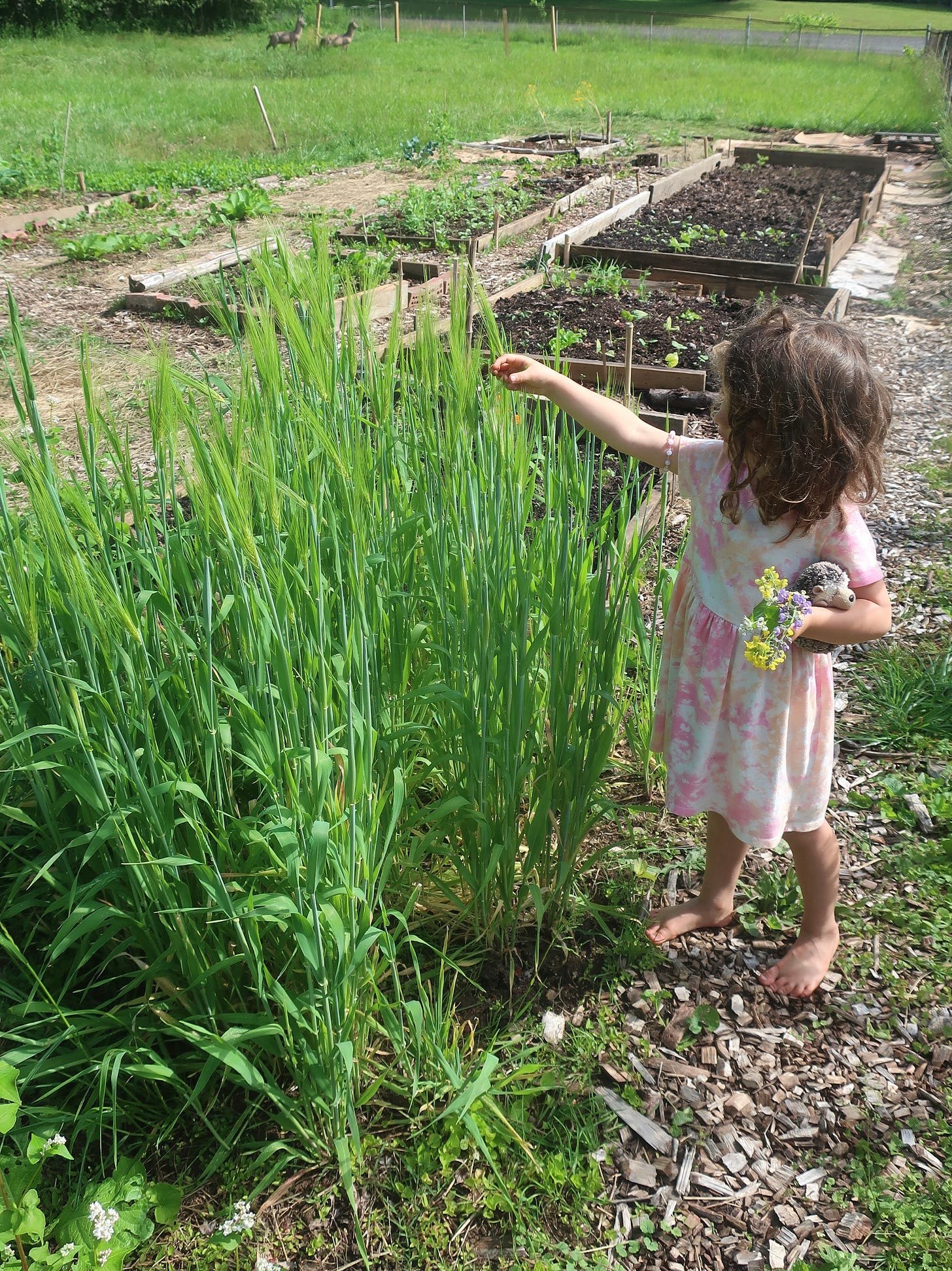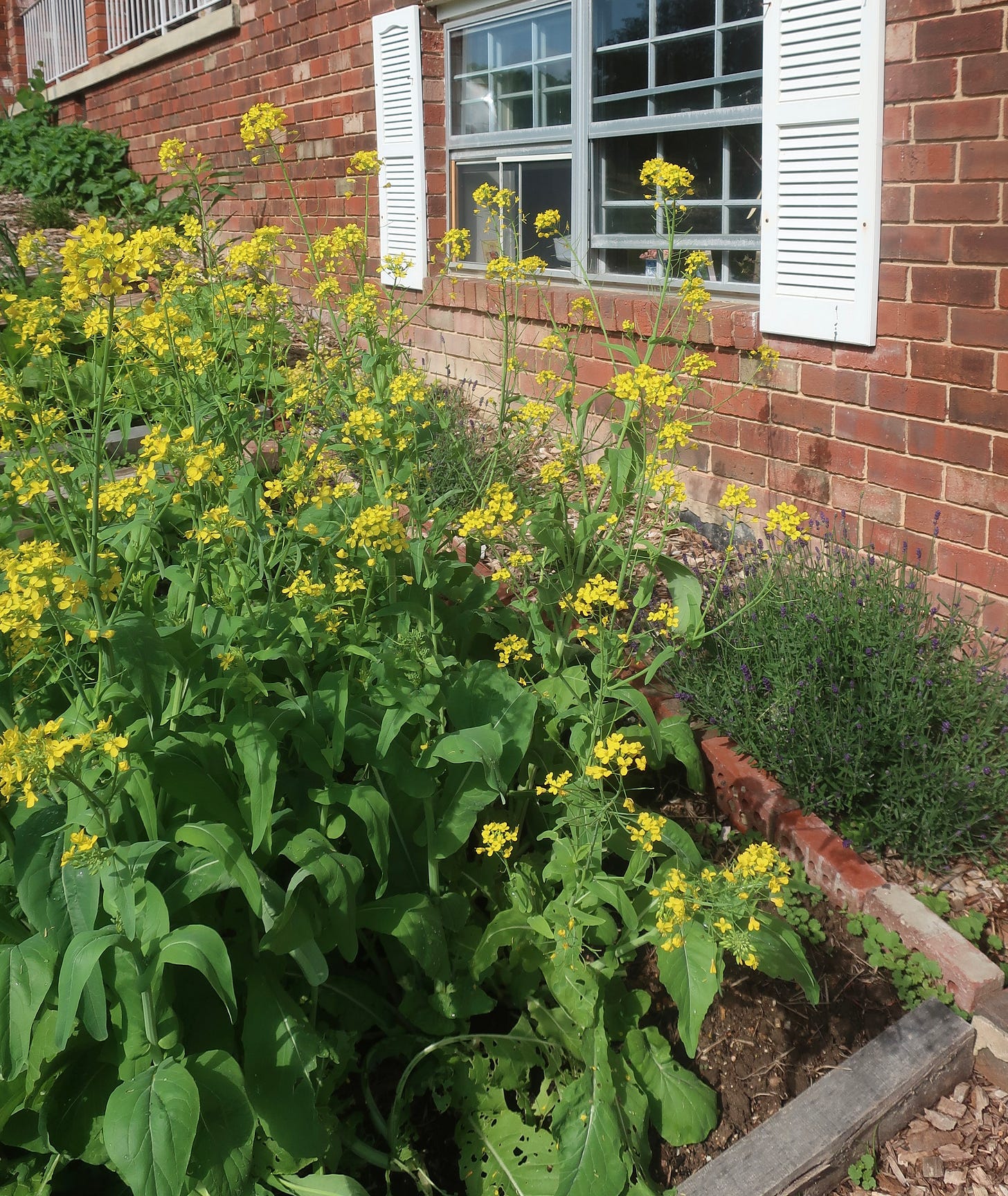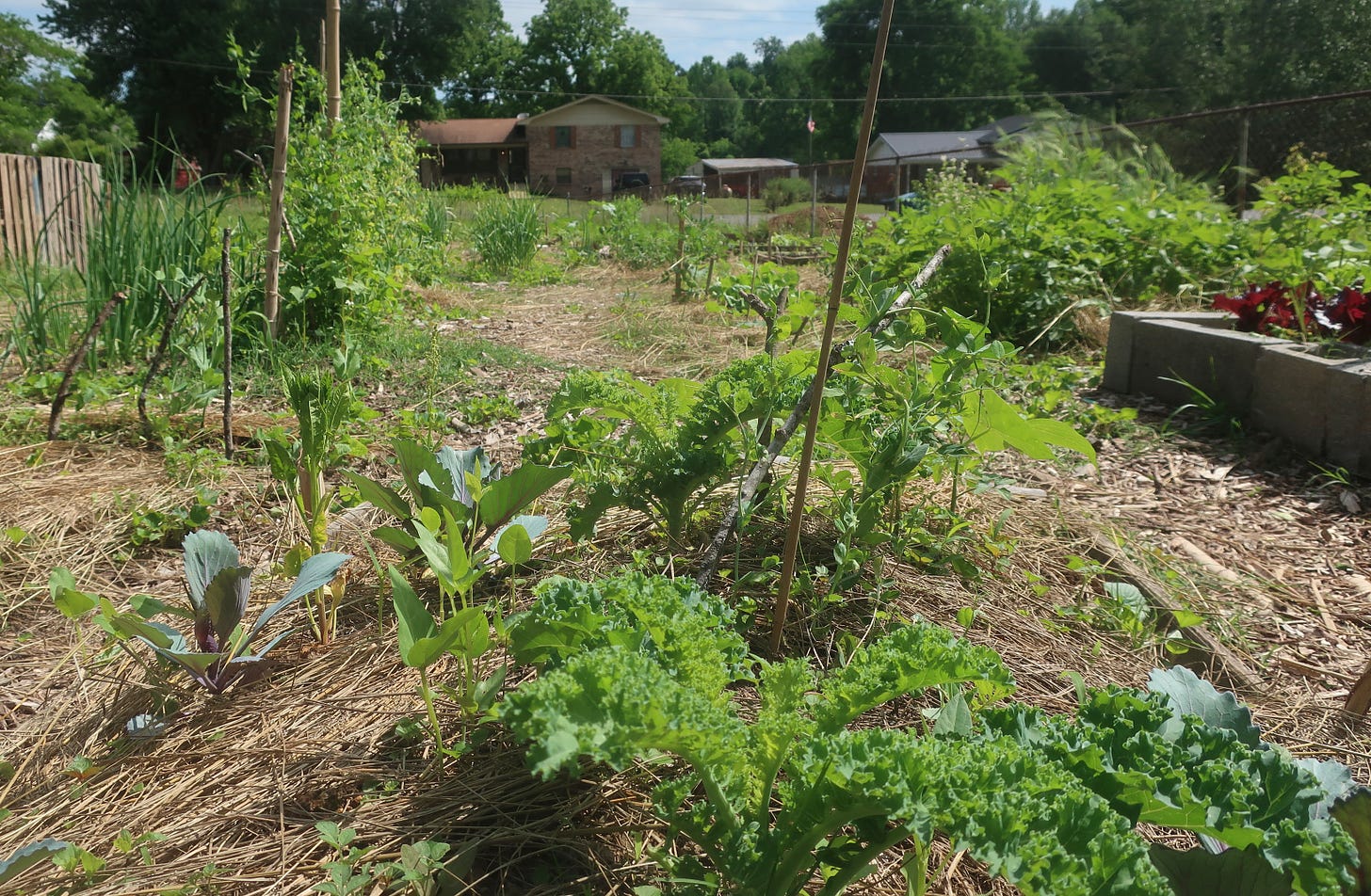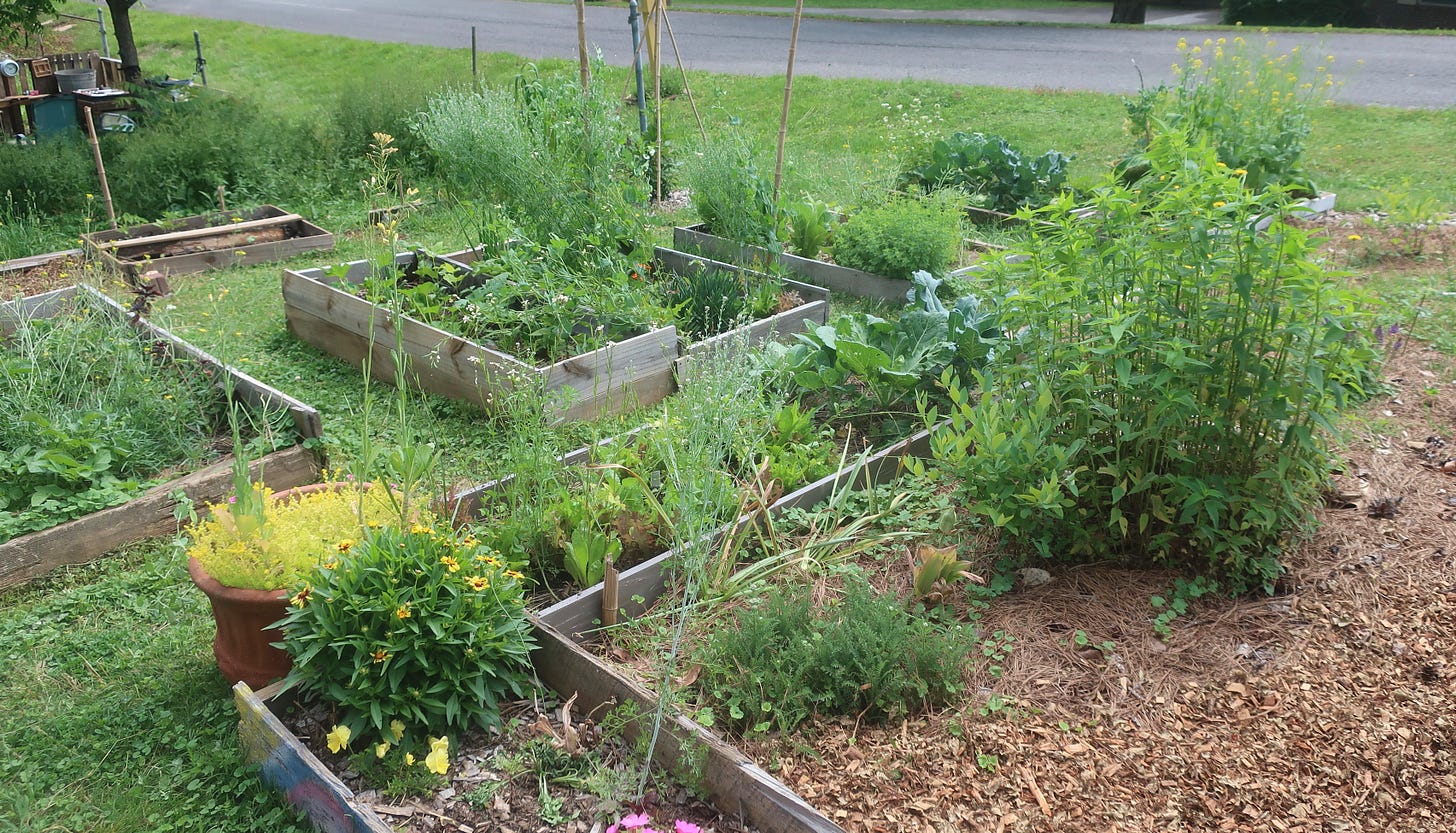Monthly Miscellany: May, 2023
Garden Goings On, Research and Writings, Odds and Ends
In lieu of my unfulfilled attempt last year to write weekly newsletters, starting this month I’d like to instead offer you, dear readers, monthly miscellanies of reports from the field (literally, in this case, as well as more metaphorically), short bits of writing on topics swirling in my head but not yet fully formed, reviews of books, and a selected piece of music and of poetry.
The weather is gradually warming towards summer here in the southwestern edges of the Appalachians, with a few really hot days already behind us, the heat and humidity of June fast approaching. Our garden—which is very gradually approaching ‘small farm’ territory—is in full swing, the spring plantings of cooking and salad greens still going strong, the summer crops getting ready to make. The photos I’ve included are now only a few days old, but much of the garden already looks substantively different—it’s such a wonderful and exciting dynamism, orderly and unpredictable in its exact parameters as things unfold! I’ve started a lot of new crops this year, in small numbers mostly, as experiments in both growing and eating; in future monthly newsletters perhaps I can give some updates on their relative success and failure. I’m working on some ideas for moving this aspect of my life in some additional directions, but I’d rather not be more specific at this juncture—suffice to say, one of the things I’ve become convinced of over the last year is that there is both more need and more latent potential around us in terms of growing a world both healthier and more beautiful. My goal for the next couple of years is to find ways to build out on that vision in practical ways, reaching people outside of my own social and cultural orbit.
One thing that I have noticed in myself since moving from the DC area to the outskirts of Chattanooga is that my capacity for political imagination has really returned: I was in general very disengaged for about a decade, not due to any great weather change in my own personal politics (though my political vision and my, if you will, political theology, has matured, I would like to think, over the last decade or so), but more because I felt overwhelmed by the scale of things there, and to boot was very much an outsider, in a city of outsiders. The human and political geography of a small city is vastly more manageable, or, rather, imaginable. No doubt some people, with dispositions and aptitudes different and probably superior to mine, flourish in such contexts, but I do not.
On the literal homefront, my goal of replacing the majority of the lawn with garden or semi-wild growth is getting closer to full fruition, sped up in recent days by the acquisition of a generous amount of wood chips from an arborist who needed a place to dump chips and avoid driving all the way to the municipal yard waste yard in North Chattanooga. Something that’s also come as a nice surprise has been the relative ease with which I’ve been able to gather the organic materials I need—the vast majority of my inputs have either been sourced from our property for free (well, other than my manual labor!) or have been donated or scavenged, such as the bags of dry leaves left for pickup I scored a couple days ago and which will feed my compost system for months to come. Less happily, developing an eye for organic waste has also further underlined for me just how massively wasteful our civilization is and how much could be so relatively easily recovered and reused by ordinary people. But I suspect I’m preaching to the proverbial choir on this point.
I didn’t do it at the time but I wish I had made an inventory of all of the species of organisms on our property when we moved in, before setting to cultivating and generally restoring this one acre. Neighboring houses with ‘conventional’ lawns provide a decent analogue, however, and the contrast in species observed is really striking. Just over the last couple of months, as insects and other creatures emerge from hibernation, the greater species richness compared to this time last year is remarkable. The soil itself is livelier, the traces of its living things visible in the abundance of macro-organisms visible in a simple turning or moving of a brick or log, in the mycelium visible in the aging wood chips in paths and flower beds, in the texture and depth of the soil in places where a year ago it was merely a thin layer atop hard clays and cherts. It’s just beautiful—glory to God!
In terms of my ‘day job’ and academic scholarship, I’m gearing up to teach an online summer course in Islamicate paleography, codicology, and manuscript studies, which will touch on many of the themes in the history of textual technologies I’ve been exploring over the last couple of years. Our Open Islamicate Texts Initiative team is also working on some very interesting and genuinely exciting projects that involve the study of manuscript culture, textuality, and digital methods, aspects of which I’ve touched on in essays here obliquely, and about which I hope to have more to say in the near future.
Recently published on my blog, for those who do not follow it as well, are a handful of translations of Arabic and Persian hagiographic texts, from books I’ve been working through in the slow process of compiling a book, though I suspect the editorial staff with whom I’ve been working on and off again have begun to think I will never finish. Sustained writing has not been easy as of late, I will be quite honest.
It’s not for lack of time, or even of energy per se: on top of my professional responsibilities and daily work, gardening and parenting and all the rest, on any given evening I have been spending time exploring new areas of inquiry, reading in Neolithic history, in some new (to me anyway) areas of philosophy and theology, and, in recent weeks, picking up the totally unrelated and highly peripheral to my academic work languages of Ge’ez and K’iche’, the former the classical language of Ethiopian Orthodoxy, the latter one of the primary early modern to contemporary representatives of the Central American Mayan family of languages. I’ve also been helping with the kids’ homeschooling, doing daily lessons in biology and in history; we’re currently working our way through invertebrate phylum in the former and ancient Egypt in the latter. In terms of writing my challenge is one of finding sustained blocks of time (see below for the real impediment to that task) but also in containing my thought, at least temporarily, into specific channels without overflowing too much into the riotous intellectual garden I’ve taken to cultivating.
On a more mundane level, I continue to struggle, as I imagine most of my readers do as well, with the avoidance of digital distraction, given that most of my daily work and all of my writing, professional or otherwise, takes place in a digital environment, in which rapid movement between tasks is so easy—I remember something else I should do or note down, communication left unfinished, data that needs cleaning, and so forth, which of course dilutes my time and energy. The ascesis of digital work is one that I am always working to refine and to stick to, even after years of experience and exposure.
Recently Read Books of Note: as usual, the following are reflective of my own rather idiosyncratic combination of interests, largely outside of my professional areas of study (with the exception of the first).
Holger Gzelle. Aramaic: A History of the First World Language. Translated by Benjamin D. Suchard. 2021.
Now, as someone whose ordinary reading fare is almost entirely material published by university presses and their equivalents, to call something a ‘page-turner’ might come as faint praise, but this book genuinely was as close to a proverbial page-turner as an academic work is likely to be! I am in the- probably bad!- habit of working through several different, unrelated books simultaneously, which means it can take me a few weeks to finish a given monograph; in this case, I sped through Aramaic in a couple of days. Part of the appeal for me came from my own knowledge of Syriac- a long-lived literary form of Aramaic- and my recent endeavors to reactive my reading knowledge of the language, but such knowledge is not a prerequisite for enjoying this scholarly work. Rather, it is the sheer chronological and thematic scope of the work, a history of a language that is hard to define yet visible seemingly everywhere, its genealogy reaching into a very distant past and yet subsisting as a living tradition right up to the present. As with any good focused histories of particular entities- languages, textual traditions, words, commodities- Gzelle’s tome also provides insight into a vast range of other historical backgrounds and topics, from the emergence of the alphabet to Mandean mythology.
Bryan N. Danforth, Robert L. Minckley, and John L. Neff. The Solitary Bees: Biology, Evolution, Conservation. 2019.
I’ve always appreciated bees to some degree and noted their presence, or absence, but since taking up gardening in an intensive and relatively large-scale way, my overall awareness and interest has blossomed like never before. I’m not alone in this, it turn outs- rather like fungi, bees (and to a certain extent, their cousins the wasps) have received an uptick in attention, driven in part by the very real and in some cases even existential threats they and other insects have been facing. This book brings into the spotlight groups of bees which have tended to fly low in the upswell of apian enthusiasm, namely, the solitary bees, many of which are indeed quite small and only become visible when you know and think to look for them. Small and solitary however hardly capture the beauty and importance of these organisms, or the pleasure of working through this book (which I suspect I will sooner rather than later be reading again!).
April Nowell. Growing Up in the Ice Age: Fossil and Archeological Evidence of the Lived Lives of Plio-Pleistocene Children. 2021.
A relatively slender tome, but absolutely fascinating, both for its lovely humanizing effect upon the histories of Late Paleolithic (mostly, though the promised earlier eras do appear some) humans and for the demonstrations of impressive archeological detective work, both in material methods and in interpretation. As a historian whose primary ambit is texts, I find that exploring resolutely pre-textual contexts is very helpful in expanding the bounds of my own thought and areas of analysis. In this case, as I was reading the ways in which scholars of the Paleolithic have sought out and interpreted traces of children in things like flint scatters and finger flutings in the clay of caves, it occurred to me that similar traces almost certainly can be found in the medieval and early modern Islamicate manuscripts with which I work. I was also struck, yet again, by what really does appear to be the peacefulness and, for lack of a better word, beauty of Paleolithic life. It’s hard to imagine whoever crafted the fearsome sculptures upon the phallic stones of Göbekli Tepe carrying children on their shoulders to the rites performed there (though, to be sure, that could just be a failure of my imagination!), but we know that such things happened in the ‘inner sanctums’ of our Paleolithic ancestors. I suspect there is a lot available to unpack here theologically, but that’s another conversation.
Dale E. Greenwalt. Remnants of Ancient Life: The New Science of Old Fossils. 2023.
This is just a delightful work of ‘popular’ science, generally striking a good balance between reading ease and the occasional slightly more technical descriptions, and covering a vast panorama of earth’s deep past as visible in some quite unlikely places. In that sense it fits in well with April Nowell’s book above—ways of seeing that are not immediately obvious but which expand our field of vision significantly. I was familiar with some of the work Greenwalt describes, but others were entirely new to me. I was especially pleased to see one of my absolute favorite fossils, the Miocene mollusk genus and Maryland state fossil Ecphora, make a cameo. Recommend, even for those now especially keen on paleontology.
Music:
When it comes to ‘traditional’ and ‘folk’ music I am generally not super enthusiastic about the use of non-traditional instruments and approaches; like a lot of so-called ‘world’ music it often sounds gimmicky and forced. That said, when done well it can be amazing—and true to the nature of ‘traditional’ music, which if it is to be genuinely traditional should be alive and expanding, in contact with other styles and methods even as it retains certain core characteristics. This recent (2022) piece by the Iranian musician Sohrab Pournazeri exemplifies good ‘experimental traditional’ music, do give it a listen:
Poem:
the vultures are dispersed now, spring dawn flown to the further quarters of the mountains and the valleys— or so I hope, is it proper to pray for the birds of the air? for otherwise it may be that they fell in the unquiet of unnatural death, in another plague loosed on the earth, eyes turned backwards and froth at the mouth, the air growing stiller, another bitter spring— an apocalypse, but without the vultures to show the body, still another sign of absence, time’s collapse. the voices getting dimmer and dumber. still I watch for them, search the skies for the wide gyres, and the coming of the Son of Man in new world making glory. so, may all our deadly dross perish, and only those forged in Thine remain!




